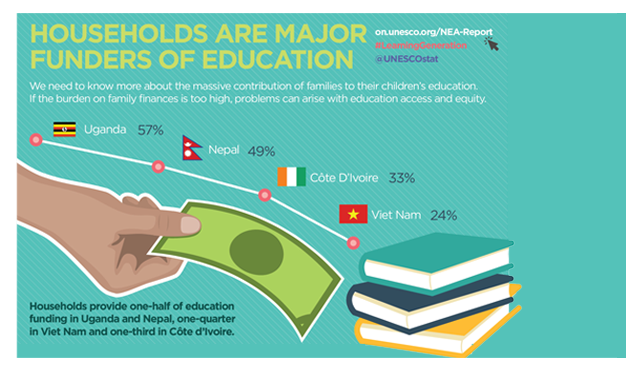Education Data Release: New Indicators and More Data for Countries in Every Region
Share
01/06/2017
Special focus on new indicators on education spending by households and governments

The UIS has issued its most important education data release of the year, with a series of newly developed indicators to inform the Sustainable Development Goals (SDGs) and a wider range of data. From early childhood educational development programmes to tertiary and adult education, the release includes updated data for 2015 and for the 2016 reference year in a small number of countries.
The release includes many of the global and thematic indicators used to monitor SDG 4, which are presented in a series of interactive maps of the eAtlas for Education 2030. With just a couple of clicks, it is possible to explore indicators, such as completion rates for different education levels, the supply of qualified teachers and government spending on education.
As part of the UIS commitment to open data, the Institute has increased the amount of data available through its API (application program interface). Data users can now download more than 3,785 indicators and data from 1970 and onwards. The UIS Data Centre also includes regional averages and new indicators on a range of issues, such as pre-primary and early childhood education, gender parity and education spending.
New data on education spending of households
For the first time, the UIS is releasing SDG indicator 4.5.4, which provides a breakdown of expenditure per student by level of education and source of funding (government and households). In particular, this indicator sheds light on the extent to which households are shouldering the costs of education – including tuition fees, textbooks and other materials – as well as the hidden costs of uniforms, for example.
There is concern that these costs prevent the poorest children and youth from going to school despite the SDG 4 promise to provide 12 years of free education. The new UIS data show that out-of-pocket expenses for families remain high even at the primary level in many countries. In Ghana, households spend annually about $87 per child in primary education, while this figure increases to $151 in Côte d’Ivoire and to $680 in El Salvador.[1]
UIS data also show that household expenses often increase sharply when students reach secondary education. Household spending per student reaches $228 a year in Ghana and $637 in Côte d’Ivoire—in the latter, this is more than four times the cost of primary education. In Benin, households are actually spending more per secondary student ($402) than the government ($259).
Households in developing countries spend more on their children’s education than in developed countries
Households in many developing countries are spending a far greater proportion of their GDP per capita on education than those in developed countries. While this demonstrates their deep commitment to the education of their children, it also raises concerns about the prospects of achieving the global education goal in cases where households are shouldering a high share of the costs. For example, household expenses on secondary education amount to 20-25% of average GDP per person in Benin, Chad, Côte d’Ivoire, Guinea, and Niger, and more than 30% in Togo. By contrast, in almost all rich countries this share does not exceed 5%.
To produce these new indicators, the UIS complemented data on household spending as submitted by countries through the UIS annual education survey with data from household surveys processed by IIEP-Pôle de Dakar in the context of Education Country Status Reports (CSR/RESEN) for 14 sub-Saharan African countries. A few additional surveys available from the World Bank Microdata Catalogue were also processed directly by the UIS, with more to come in the next data release in December.
The UIS is the official source of international education data, which are featured in flagship publications and databases, such as the World Development Indicators (World Bank), the State of the World’s Children (UNICEF), Global Education Monitoring Report (UNESCO), the SDG Progress Report (United Nations Statistical Division), and many others.
The UIS education database is updated twice each year. New global and regional data on out-of-school-children and youth will be released in June 2017 as part of a policy paper that will analyse trends.
To consult the latest available statistics, visit the Data Centre:
Then follow these three simple steps:
1. Click on "Data by theme"
2. Select the theme “Education”
3. Select a data table
4. Click "Customise" to select indicator, country and year(s)
[1] Expenditure amounts are reported in international dollars (purchasing power parity, PPP), which are calculated by adjusting exchange rates in accordance with national price levels. An international dollar buys a comparable amount of goods and services in a given country as a U.S. dollar buys in the United States (https://datahelpdesk.worldbank.org/knowledgebase/articles/114944-what-is-an-international-dollar).